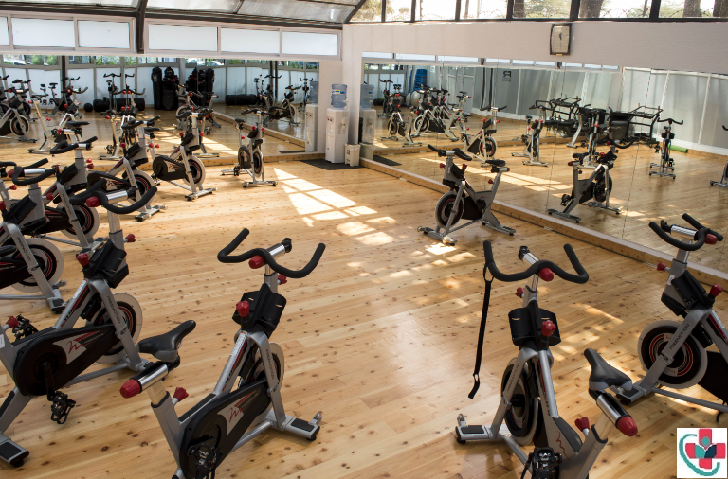If you’re new to the spin world, it can seem a little intimidating at first. But you really don’t have to be a pro-cyclist to give it a go and reap the benefits.
The hardest part of Spinning isn't the climbs. It's avoiding the many variables (seat height! resistance! posture!) that could mess with your form, efficiency, and overall workout. Avoid these mistakes to make the most of your sweat session.

You're not following the workout.
Your instructor is setting you up for sweaty success, so listen closely to determine how much resistance should be on your wheel. "A good instructor will describe the terrain you're riding—a flat road or a heavy hill, for example—and how hard you should be working," says Carlucci. This isn't the place to march to the beat of your own drum. Stick to the instructions and you'll likely feel a mental boost too, as many classes are set up to "ride as a pack" to bolster team camaraderie.
That resistance is too low.
"All too often I see people riding with too little resistance," says Carlucci (yep, it's obvious when you do it). "Resistance is where the magic happens. If you're looking to burn calories, you do it by powering through the resistance, by upping your challenge, by increasing your workout output." In other words, the more you crank that knob to the right, the stronger you get. Not to mention that a too-low resistance makes your cadence too fast, putting you at risk for damaged joints. How can you tell there's not enough? "If your hips are bouncing or your pedal stroke is too loose or your shoe pops out of the clip, those are sure signs," he says.
On the flip side, your resistance could be too high.
If you can't match your pedal stroke to the beat of the music, or stay within the RPM range that your instructor is coaching, turn that knob to the left until you can. "If your instructor is coaching you to feel breathless and be working hard while staying with the beat, your resistance should be high," says Roaman. "If they're cuing you to take it easy while sticking to the beat, it should be light."
You fling your elbows out during a "tap back."
It's one of the most popular moves in Spinning classes these days, and it's designed to activate your glutes and core by driving your hips backward, "tapping" it over the saddle without fully sitting. But if you fling your elbows out to your sides (let's be honest, it's usually done to accentuate the movement when you're feeling the music), you add tension to your shoulders and take away some of the booty-blasting effects of the exercise, says Roaman. Instead, keep your arms close to your sides, with a slight bend in the elbow, as you tap back.
You party too hardy on the bike.
We get it—a rockin' playlist makes you want to groove on that bike like it's 1999. But swaying side to side throws your body off-balance, forcing you to grip the handlebars tightly. Instead, channel that energy into perfectly matching your cadence to the beat (and crank the resistance if that feels too easy)—and add a little headbang for good measure.
You death-grip the handlebars.
Those babies are there for stability, not support. Relying on them to support your weight takes away the core and quad work you're after, says Carlucci. Flutter or flex your fingers during the hard parts (we do it a lot during sprints out of the saddle) to check in on form throughout the class.
You don't pull up on the pedals.
It's all about finding the perfect balance in your pedal stroke to make your stride as efficient as possible. "If you're just pushing down, you're overtaxing your muscles," says Hickl. "The downstroke will happen naturally, so if you focus on lifting the opposite foot, you're engaging the hamstring and glute muscles, and balancing the work in your legs from front to back." Translation: Don't make your quads do all the work—letting your hammies in on the action gives you more power.
You don't let the music move you.
"A good instructor will know how to curate a playlist that is true to himself or herself, while simultaneously appealing to as wide an audience as possible," says Carlucci. "Like a good meal, it should have hints of several flavors. They'll know how to finesse the musical phrasing and dynamics in relation to the physical activity on the bike, appearing to have command over that beat." So if you're not really jibing with the tunes, try a new class until one click. You'll leave feeling even more invigorated.
You skip the stretch.
It's one of the most important parts of the workout, so opting out nixes your jump start on the recovery process. Plus, it's annoying. "You're opening the door and letting all that light stream into a dark room, disrupting that experience the instructor is working so hard to create," says Carlucci. If you catch yourself doing this on the reg, consider hitting up an earlier class so you're under less of a time crunch. And if you need to leave early for something unexpected, just signal to the instructor that you're OK—otherwise, they'll worry you're injured.
